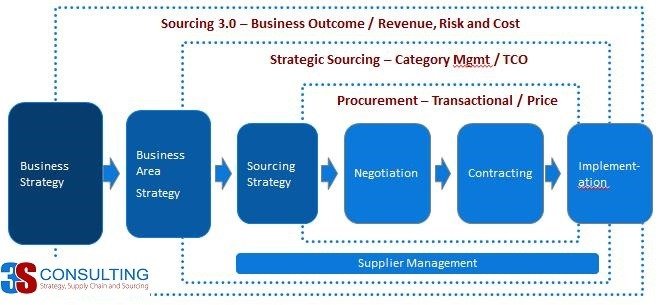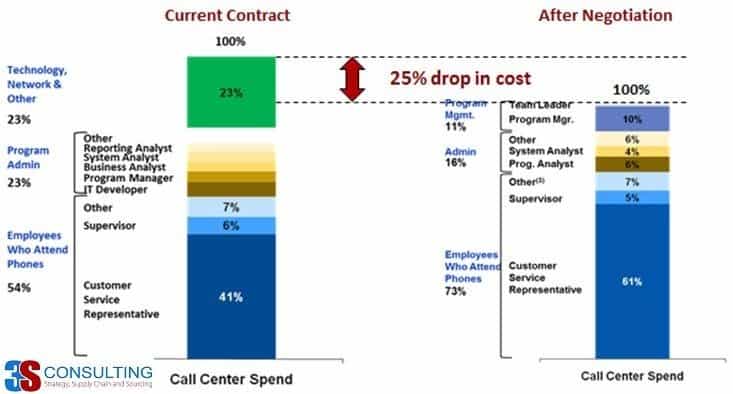The Future of Sourcing – Business Partner to Business Leader

Evolution of Sourcing / Procurement Organization

What’s next?
Logically, the next evolution will probably see sourcing professionals directly contributing to business strategy — moving from being a cost center to becoming an essential part of the business very similar to its marketing or R&D organizations. For want of a better term, I am calling the next evolution as Sourcing 3.0. A sourcing team’s contribution to company strategy will be through developing and managing strategic suppliers who will drive business outcomes like increased revenue, reduced dangers or decreased price in a business level. Strategic providers can execute a variety of role for a company. They have a considerable effect on business outcomes. Traditionally, these providers were considered out of scope for sourcing organizations since they needed different skills and toolkits than currently exist, and companies preferred to manage them directly.
CPOs recognize strategic suppliers as an opportunity area but emphasize the issues with insufficient toolkits and abilities in their company to effectively engage these providers.
What are these different skills and toolkits?
Working with strategic providers needs two essential skillsets — a collaborative mindset and an analytics-based approach. This differs from the approach used for category management where market / competitive forces drive efficiency.
As an example, among the tools we’ve employed is the “Should Cost” modeling. We’ve used the “Should Cost” models across many industries and corporations where we readily shared the information with the strategic suppliers. This approach demands financial and analytical experience in addition to the commercial expertise typically needed from a buyer in a strategic sourcing organization. Additionally, it requires “influencing skills” to treat suppliers as real business partners. These multi-year relationships need careful ongoing relationship management by linking performance to business goals.
Example of a toolkit – “Should Cost” modeling
Sourcing organizations have been developing cost models. It’s critical for strategic suppliers as understanding the underlying costs can identify opportunities for outcome improvements.
This concept is sometimes confusing to our clients as they believe the objective of cost modeling is to decrease costs, and they don’t understand the linkage between the improvement of result or service. Cost modeling is a tool that can also identify areas where cost could be added or redirected so as to improve service or quality of the product in addition to making the operation more efficient.
Below is an example of a should cost modeling. A technical call center contract at a Pharmaceutical company required that the provider maintain infrastructure at a particular location with a set of stringent technical requirements. The requirements changed significantly over time due to changing business environment; however, both firms struggled to figure out how best to redefine their relationship.
Should Cost modeling showed significant potential for service improvement by spending more on agents who attend the phone and less on overhead areas like program management and administration. The change in the contract was also a win for the provider as they now have greater flexibility in establishing the infrastructure and location.
Restructuring of Strategic Call Center contract through Should Cost Modeling

How then do we affect change?
Creating these new capabilities could be the change agent which will evolve sourcing organizations from a cost center to becoming an integral part of the business enterprise. This resembles the category management expertise that led to the evolution of the procurement organization to a strategic sourcing organization in the late 1990s and early 2000s.

It works really well for me
I enjoy the article
Thanks to the excellent manual
Everything typed made a bunch of sense. But, think on this, suppose you
added a little information? I ain’t saying your
content isn’t good., however suppose you added a post title that makes people desire more?
I mean The future of sourcing is kinda plain. You should look at Yahoo’s home page and note how they create news headlines to grab viewers to click.
You might add a related video or a pic or two to get readers
excited about what you’ve got to say. Just my opinion, it could
make your posts a little livelier.
Undeniably believe that which you said. Your favorite justification appeared to be
on the net the simplest thing to be aware of. I say
to you, I certainly get annoyed while people consider worries
that they plainly do not know about. You managed to hit the nail upon the top as well as defined out the whole thing without having side
effect , people can take a signal. Will probably be back to
get more. Thanks
Admiring th? commitment ?ou put into your site ?nd detailed informat?on you
offer. It’s go?d to com? ac?oss a blog
evry ?nce in a while that isn’t the s?me unwanted rehashesd material.
Fantastic ?ead! I’v? saved your site ?nd I’m adding you? RSS feeds t? m? Google account.
Thanks for the article you had shared. Your justification is simplest.
Very Good Article with useful content .Thanks for info
Good content which is worth reading it . Thanks for information